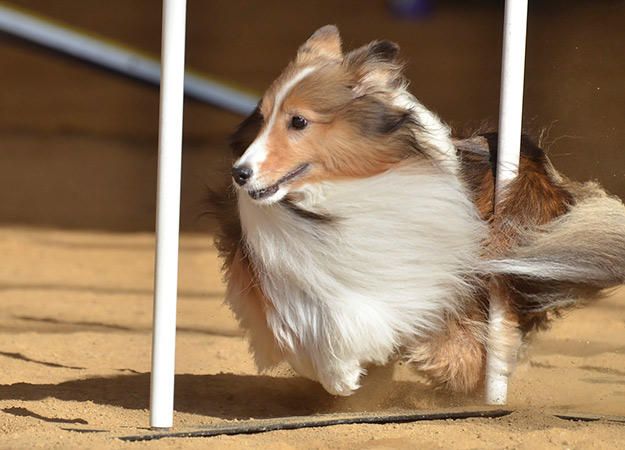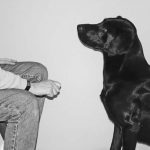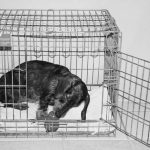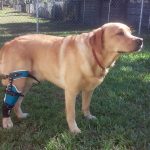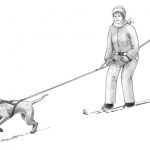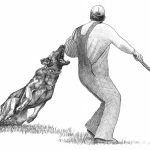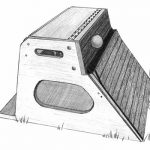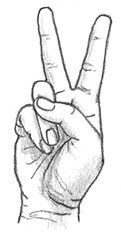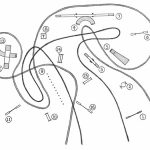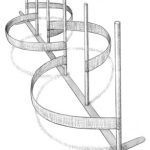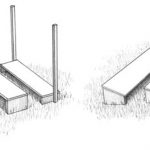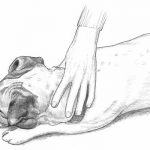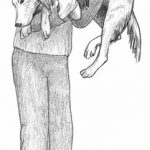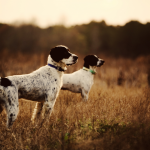- Deciding on your dog’s diet
- Bathing your dog
- Clipping your dog’s nails
- Caring for your dog’s facial features
You’ve seen dogs bouncing down the street at the end of a leash or streaking across the park after a tennis ball. Nails clipped, coats gleaming, white teeth flashing . . . can dogs actually sparkle?
If your dog looks a little unkempt compared to these wondrous creatures, don’t despair. This kind of radiant health doesn’t require a full-time staff of groomers, nutritionists, and fitness coaches. With a little time, effort, patience, and love, your dog can sparkle with the best of them!
This chapter shows you the top ten things you can do to maintain your dog’s health. You discover the healthiest foods, the tastiest snacks, and the best grooming tools to manage the job efficiently and easily. Best of all, you find that canine health and fitness can be fun — you can bond with your dog while you care for your dog. So hang up a wind chime and get started — it’s dog spa time!
Give Water, Water, Water
Technical Stuff
Your dog can live three weeks without food, but she’ll die within days without water. Water is necessary for all digestive processes as well as regulating temperature, absorbing nutrients, and shipping things between organs and out of the body.
How much water your dog needs depends on her physical activities and the type of food she eats. Panting is your dog’s way of sweating, and if your dog is sweating, she needs a drink.
Dry food also encourages thirst. Because dry food contains only 10 percent moisture, your dog needs about 1 quart of water for every pound of dry food. On the other hand, canned food or home-cooked diets contain more water and require less to rinse and wash down. (This attribute of canned and home-cooked food doesn’t necessarily make them a superior food source, however. See the later section “Feed Your Dog Quality Dog Food” for details.)
Remember
Water is vital for survival. Make sure clean water is always available for your dog. Provide clean water in a stainless steel dish and change it regularly. Each time you fill your dog’s bowl, rinse it to clean off dirt and other nasty particles that don’t belong in a fresh bowl.
Encourage Regular Exercise
If your dog hasn’t been out for a good run in a long time, you need to ease her in slowly. Conditioning for dogs is like conditioning for people: a necessary evil. To preserve your dog’s good health — and before you jump into a new tricks-training regime — you need to make sure she’s in top physical shape or has a program to get her there. Just like humans, pushing your dog too far too fast can lead to trouble.
Start with conditioning for tricks and obedience. Most of the stunts I outline in this book don’t require tremendous amounts of physical exertion. However, if your dog has been off the training wagon for some time, do the following:
– Keep the lessons short and upbeat to start, no more than 3 to 10 minutes. She doesn’t have to master a trick a day. You can have practice sessions three times a day if your schedule allows, but short lessons are best.
– Start with tricks that are easy for her to master and that make you laugh. Laughter is great encouragement.
Conditioning for athletic activities is another issue. Are you pumped up to start racing that dog of yours over every tree and up ladders? Whoa, Nellie! Your dog will want to try everything you introduce her to, but is she ready? If your dog can’t tell a tree stump from an ottoman, start small. There’s no need to conquer the world in a day. First, take a couple of weeks to make sure your dog can handle the excitement. Go for half-mile hikes, building the distance over time.
Remember
Growing pups are in the majority where sports injuries are concerned (see Chapter Top Ten Sports Injuries for Dogs for info on sports injuries). A 4-month-old pup will run until her legs can’t carry her, but all that exercise can permanently alter her growing body and cause problems later in life. A young dog’s energy and enthusiasm can be quite misleading: She’ll want to try everything and give no thought to the consequences. Overly strenuous activity, slippery footing, or excessive jumping causes trauma to bones and joints. During your puppy’s growth phase — 4½ to 9 months — keep her activity level regulated and don’t encourage jumping. I know — teaching your dog new stuff is a lot of fun, but you need to be the parent here and do what’s best for your dog.
Feed Your Dog Quality Dog Food
Aren’t all dog foods basically the same? No, Virginia, they’re not. The only true similarity is in the percentage of components required to meet a dog’s daily allowance, which is governed by the AAFCO (Association of American Feed Control Officials). To pick the right food, you need to know how to read ingredient labels. You may discover that the most costly, aggressively marketed, or cleverly labeled food isn’t necessarily the best.
To pass regulatory standards, dog foods must contain six essential elements: protein, fat, carbohydrates, vitamins, minerals, and water. But that’s where the similarities usually end. The makers of dog foods diverge on which ingredients they use to reach the minimum daily requirement (MDR). For example, some use soy (a vegetable protein) to meet the daily protein requirement, whereas others use animal protein. This section looks at the essentials one at a time.
Protein
Protein is the most expensive ingredient in dog foods, and its source often determines the quality of the food. Animal sources are superior. Unfortunately, there’s not enough meat around to satisfy all the pet dogs in the world, so the producers often substitute vegetable protein.
Tip
Rationing treatsDuring trick training, you often hand out treats in great abundance (to say the least). Pick a sugar-free breakfast cereal or morsel of a light dog snack to keep calories down, and reduce your dog’s regular meals slightly to compensate. Whatever you choose, remember it’s not the amount that counts, but the act of giving — you don’t need to give a lot to show reward. |
The difference between vegetable and animal protein? Vegetable protein is often harder to digest, and the dog has to consume more of it to meet her needs. More food equals more stool. My advice is to find a food that uses more animal protein than vegetable protein and requires smaller rations to meet the MDR.
Tip
Next, consider your lifestyle. Do you have a lot of free time to train your dog and engage in high-energy activities? Performance foods with high levels of crude protein provide lots of energy to burn. Puppies also need higher amounts of protein for their growing bodies.
Carbohydrates
Some dog-food manufacturers meet the MDR for protein by using primarily vegetable matter. Vegetable sources of protein also contain high levels of carbohydrates — not a bad diet for humans, but what’s good for a human isn’t always good for a dog. The reason humans digest carbohydrates well is that they start digestion in their mouths, chewing and breaking down the food. Dogs don’t chew, they gulp, and their digestion doesn’t begin until the food gets into their stomach.
Fats
Warning!
Please don’t ever buy fat-free dog food. I know it sounds tempting, but your dog needs plenty of fat to keep her skin and coat healthy and for overall body functions.
Fat gives your dog energy and keeps her cool when it’s warm and warm when it’s cool. How does it do this? Fat is an insulator, protecting the body from extremes in temperature. Neat, huh?
The recommended amount of fat is 15 to 19 percent, and many nutritionists will say for dogs, more fat is better! Why? Because carbohydrates are what add bulk for dogs, whereas fat gets utilized for body functions in dogs.
Vitamins and minerals
Have you ever wondered what vitamins do and why they’re necessary for good health? Vitamins do two things: unlock nutrients from food and make energy. Fascinating, huh? Minerals are a lot like vitamins: They help the body maintain its normal daily activities, such as circulation, energy production, and cell regeneration.
Warning!
Do not supplement your dog’s diet with vitamins and minerals unless directed by your veterinarian. Too many vitamins or minerals can cause health problems.
Brush Up on Grooming: The Peanut Butter Connection
Grooming can be your worst nightmare or your best friend. If the thought of brushing your dog troubles you, try this approach:
1. Start with a soft-bristled brush.
You may use a firmer brush when your dog is more accepting, but soft is better when starting out.
2. Call your dog aside happily and give her a treat when she comes.
3. Take some peanut butter and rub it on the refrigerator at your dog’s nose level.
4. While she licks it off, say “Stand” and brush gently.
Praise, too!
Begin with short grooming sessions, quitting once your dog is through licking off the spread. Gradually extend from 30 seconds to several minutes, giving your dog treats or a bone to occupy her while you gussy her up.
Tip
The peanut butter trick also works wonders when you have to towel-dry or wipe a dog’s paws. If early association with the activity is positive, your dog will be much easier to handle down the road. If your dog’s not a big peanut butter fan, try some soft cheese, yogurt, or meat broth.
Give a Bath
Every dog has to take a bath sometime. Short-coated breeds need a bath less often than long-coats — unless, of course, they’re avid excrement rollers.
To make the bath a positive experience, lay a towel on the bottom of the sink or tub for your dog to stand on comfortably without slipping, and spread peanut butter around the edge to occupy your dog while you scrub. You can bathe small dogs in the sink; large breeds fit best in a tub or can be hosed outside on a warm day.
Tip
Shampooing a malodorous mutt makes her socially acceptable, but it also strips away natural oils in a dog’s coat. Shampooed too often, the coat will dry out and become brittle, so bathe your dog only about once a month.
Warning!
Cut out mats or ask a professional groomer to do this for you. Mats are extremely annoying and painful — like having a knotted tangle that pulls on your skin all day. Distracting and irritating, a mat won’t bring out the best in any dog!
Keep Your Dog’s Nails Clipped
If nails grow too long, they can crack, break, or become ingrown. Ouch! Unfortunately, dogs don’t relate to the whole manicure thing the way some people do. Using treats or peanut butter can calm the most savage beast.
Nail clippers for dogs look like a downsized guillotine — sharp and defining. The hand-clasp action provides the power needed to cut through a dog’s nail. Don’t try human clippers — they’re not strong enough.
When clipping, make sure you clip the very tip of the nail, just as it starts to curl. If your dog has light-colored nails, you can see the delicate blood vessel inside; that’s the part you want to avoid!
Remember
Don’t overlook dew claws or hind nails. Though they grow more slowly, they still need your attention.
If your dog isn’t comfortable having her feet handled, make it a part of your everyday interactions. Handle the feet when giving a treat, petting, or feeding. Tell your dog how wonderful her feet are. Kiss them when she’s sleeping. (Okay, you don’t have to kiss your dog’s feet, but you can.)
Warning!
Be very careful to avoid cutting into your dog’s tissue! Aside from being excruciatingly painful, the wound can bleed for hours. To prevent excess bleeding, get a clotting solution, such as styptic powder, from your veterinarian. It works like magic. In a pinch, you can use a little bit of cornstarch, but the clotting solution is better.
Be Easy on the Eyes
Dogs don’t spend as much time on their looks as you do, but that doesn’t mean their facial features should go unnoticed. Eye irritations can blur their vision and cause disorientation. Soulful, sweet, comic — your dog’s eyes tell it all. It’s up to you to keep the eyes healthy, bright, and clear.
Tip
If you have a longhaired breed, carefully clip the hair surrounding the eyes — the better to see you with!
If your veterinarian prescribes eye medication, administer it carefully. Use peanut butter on the fridge or a bowl of broth in a friend’s lap to occupy your dog while you medicate her. Place your hand carefully under your dog’s chin and pull the lower eyelid down until you see the white part. Squeeze the drops in there.
Keep the Ears Clean
Ears mesmerize me. I can lull myself into a trance petting a dog’s ears, and it doesn’t seem to matter what shape — uprights, floppy, short, or cropped. Dogs seem to love the ear massage, too.
Different dogs require different cleaning schedules, from every couple of weeks to daily. Your dog’s activity, diet, and the weather also influence the frequency of cleaning. If your dog is an Olympic swimmer, I suggest daily cleaning before bed. In most cases, twice a month is sufficient.
To clean the visible surface area of your dog’s ear, ask your veterinarian to recommend a commercial ear solution that will prevent infection. Soak a cotton swab with the solution and wipe the visible surface area of your dog’s ear.
Warning!
Never, never, never use a Q-tip or poke your finger into your dog’s ear. You can do irreparable damage to your dog’s inner ear.
Protect the Nose
Technical Stuff
When I was growing up, people used to say you could tell a dog’s mood by touching her nose. If it was hot, the dog was sick; too dry, the dog was depressed. The truth is there’s no truth to that old wives’ tale. A dog’s nose can heat up in a warm environment and can dry out when the air is dry. If you want to know if your dog’s running a fever, take her temperature — rectal style!
A dog’s nose can become discolored from the sun, from an allergic reaction to a food dish, from hypothyroidism, or from household detergent. In such cases, use a stainless steel feeding bowl and clean house with environmentally safe products. And when your dog goes out into the sun, protect that nose with SPF 45 sunblock!
Avoid a Foul Mouth
I have one obsession: It’s my teeth. I love brushing, flossing, and going to the dentist. Odd, I know. Based on this, you probably know what I’m going to suggest before I even write it: You must take care of your dog’s teeth. Though dogs are less prone to tartar buildup than you are, they’re not immune. Sure, they have more concentrated saliva and they chew bones and things, but this doesn’t take the place of dental care. Without a little help from their friends (that’s you), they’ll suffer from tooth decay, abscesses, periodontal disease, and tooth loss.
To keep your dog’s teeth healthy, do the following:
– Provide chew toys.
– Brush your dog’s teeth once a week, using special canine peanut butter-flavored toothpaste. If your dog won’t settle for the brush, use your finger.
– Avoid human toothpaste; fluoride and dogs don’t mix. Many human formulas also contain Xylitol, which is toxic to dogs if swallowed.
by Sarah Hodgson
